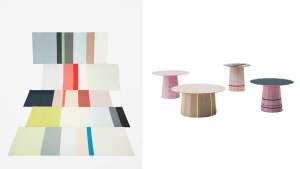From the Series
Standing alone on stage without his wife and designing partner Carole Baijings, Stefan Scholten says: “Carol and I have produced what undoubtedly is our most beautiful design.” This beautiful design is their son and his birth kept Baijings at home in the Netherlands.
The context of being Dutch, their personal design method – “the atelier way of working” – and the process of scaling up from edition design to mass production are important aspects of Scholten & Baijings’ design philosophy.
The duo design interior products in collaboration with high-profile brands around the world. One of their most prominent designs is the Colour One concept car in collaboration with Mini Cooper, which they installed and exhibited in the Cape Town International Convention Centre at Design Indaba 2014.
Scholten canvasses the Dutch design approach as a whole from Van Gogh and Rembrandt to more contemporary designers such as Tejo Remy and Hella Jongerius. “This so-called Dutch design is often named ‘droog’,” he says. The aesthetics of the “droog” design are characterised by minimalism, experimentation, innovation, counter-convention and humour.
Though Scholten studied at Eindhoven during the “droog” design era, he was not typically a droog designer himself. He and Baijings followed their own course:
The way we work in our workshop is very special. We create new forms by working with paper models and we call this the atelier way of working.
The method was developed while Scholten & Baijings lectured at the Design Academy Eindhoven. Their teaching experience helped to crystallise their now signature way of working. They use this approach to design in their small studio with eight staff in the city centre of Amsterdam.
We are first and foremost designers who think functionality is just as important as the beauty of the product.
“Our signature and key words are colour, rich details, transparency, coupled with hand-drawn illustration and a combination of different materials. We use these elements to change anonymous mass production into products with a personal touch and into objects that stand the test of time.”
We think in colour; it’s not a last minute afterthought.
Scholten & Baijings have been commissioned to produce edition designs – many of which have been scaled up to production design level. The Colour Plaid blanket they designed for Thomas Eyck is one example. Their love of textiles began with this project and it was the product of a happy accident. Instead of producing a fluid colour transition, they produced abrupt stripes.
“We realised mistakes can be used to our advantage which has opened new ways of working for us.” The Colour Plaid blanket is one of their best-selling products and is available commercially.
Scholten & Baijings produced a collection for Maharam, well known for their collaboration with le Corbusier, Charles and Ray Eames, and Alexander Girard. They used their atelier method to produce this range: after sketching, they made small-scale samples and created colour and pattern compositions.
For the Colour One project, Mini wanted a different approach for the consumer experience. So they decided to examine what the idea of a concept car was, and produced it. They started the production by parking a Mini in their studio and “unpeeling it like an onion.”
With the bare skeleton of the Mini exposed, the design studio identified the visual and structural fundaments of the Mini which gave their ideas more direction. The concept car questions the traditional status quo of the bodywork and the materials used in a car by dissecting the design process.
“Our markets are changing and as designers we have to remain focused on consumer choice even if that is something as intangible as experience,” he says.
“I think that it’s our aim to create a product that will contribute something unique to the world.”










